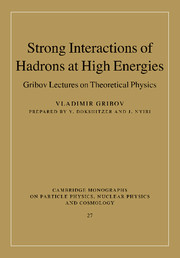Book contents
- Frontmatter
- Contents
- Foreword
- 1 Introduction
- 2 Analyticity and unitarity
- 3 Resonances
- 4 Electromagnetic interaction of hadrons
- 5 Strong interactions at high energies
- 6 t-channel unitarity and growing interaction radius
- 7 Theory of complex angular momenta
- 8 Reggeon exchange
- 9 Regge poles in perturbation theory
- 10 Regge pole beyond perturbation theory
- 11 Reggeon branchings
- 12 Branchings in the s channel and shadowing
- 13 Interacting reggeons
- 14 Reggeon field theory
- 15 Particle density fluctuations and RFT
- 16 Strong interactions and field theory
- Postscript
- References
- Index
12 - Branchings in the s channel and shadowing
- Frontmatter
- Contents
- Foreword
- 1 Introduction
- 2 Analyticity and unitarity
- 3 Resonances
- 4 Electromagnetic interaction of hadrons
- 5 Strong interactions at high energies
- 6 t-channel unitarity and growing interaction radius
- 7 Theory of complex angular momenta
- 8 Reggeon exchange
- 9 Regge poles in perturbation theory
- 10 Regge pole beyond perturbation theory
- 11 Reggeon branchings
- 12 Branchings in the s channel and shadowing
- 13 Interacting reggeons
- 14 Reggeon field theory
- 15 Particle density fluctuations and RFT
- 16 Strong interactions and field theory
- Postscript
- References
- Index
Summary
We have a serious task ahead: to analyse and sum up the branchings, taking into account how they influence each other, and to learn how to write the amplitudes respecting unitarity.
Reggeon branchings from the s-channel point of view
The s-channel approach
In Lecture 2 we discussed how, given a particle spectrum, we can construct interaction amplitudes with the help of unitarity conditions and analyticity (dispersion relations). The dispersive method is well formulated and straightforward but not very convenient in practice. So instead of iterating the amplitudes through the non-linear unitarity relations we draw series of Feynman diagrams which satisfies (at least term by term) the unitarity condition.
Now we face an opposite situation for the first time. We discovered the branchings and found the specific unitarity conditions they satisfy. Can we construct an effective field theory that would generate the reggeon unitarity conditions?
There are two ways of attacking the problem.
One can explicitly construct an effective reggeon QFT directly in the t-channel, identifying reggeons with particles of a non-relativistic (anti-hermitian) field theory in 2 + 1 dimensions.
Alternatively, we can solve the problem of constructing the reggeon diagrams which solve the unitarity conditions, working directly in the s-channel.
The two routes yield the same results. We will follow the second one, for a number of reasons.
- Type
- Chapter
- Information
- Strong Interactions of Hadrons at High EnergiesGribov Lectures on Theoretical Physics, pp. 311 - 333Publisher: Cambridge University PressPrint publication year: 2008



